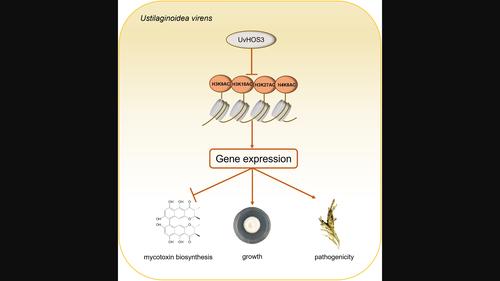当前位置:
X-MOL 学术
›
Mol. Plant Pathol.
›
论文详情
Our official English website, www.x-mol.net, welcomes your feedback! (Note: you will need to create a separate account there.)
UvHOS3-mediated histone deacetylation is essential for virulence and negatively regulates ustilaginoidin biosynthesis in Ustilaginoidea virens
Molecular Plant Pathology ( IF 4.9 ) Pub Date : 2024-02-14 , DOI: 10.1111/mpp.13429 Bo Wang 1, 2, 3 , Guohua Duan 2 , Ling Liu 2 , Zhaoyi Long 2 , Xiaolong Bai 2 , Mingming Ou 2 , Peiying Wang 2 , Du Jiang 1, 3 , Dayong Li 2 , Wenxian Sun 1, 2
Molecular Plant Pathology ( IF 4.9 ) Pub Date : 2024-02-14 , DOI: 10.1111/mpp.13429 Bo Wang 1, 2, 3 , Guohua Duan 2 , Ling Liu 2 , Zhaoyi Long 2 , Xiaolong Bai 2 , Mingming Ou 2 , Peiying Wang 2 , Du Jiang 1, 3 , Dayong Li 2 , Wenxian Sun 1, 2
Affiliation

|
Ustilaginoidea virens is the causal agent of rice false smut, which has recently become one of the most important rice diseases worldwide. Ustilaginoidins, a major type of mycotoxins produced in false smut balls, greatly deteriorates grain quality. Histone acetylation and deacetylation are involved in regulating secondary metabolism in fungi. However, little is yet known on the functions of histone deacetylases (HDACs) in virulence and mycotoxin biosynthesis in U. virens. Here, we characterized the functions of the HDAC UvHOS3 in U. virens. The ΔUvhos3 deletion mutant exhibited the phenotypes of retarded growth, increased mycelial branches and reduced conidiation and virulence. The ΔUvhos3 mutants were more sensitive to sorbitol, sodium dodecyl sulphate and oxidative stress/H2O2. ΔUvhos3 generated significantly more ustilaginoidins. RNA-Seq and metabolomics analyses also revealed that UvHOS3 is a key negative player in regulating secondary metabolism, especially mycotoxin biosynthesis. Notably, UvHOS3 mediates deacetylation of H3 and H4 at H3K9, H3K18, H3K27 and H4K8 residues. Chromatin immunoprecipitation assays indicated that UvHOS3 regulates mycotoxin biosynthesis, particularly for ustilaginoidin and sorbicillinoid production, by modulating the acetylation level of H3K18. Collectively, this study deepens the understanding of molecular mechanisms of the HDAC UvHOS3 in regulating virulence and mycotoxin biosynthesis in phytopathogenic fungi.
中文翻译:

UvHOS3 介导的组蛋白脱乙酰化对于毒力至关重要,并负向调节绿粉菌素的生物合成
黑粉菌是水稻黑穗病的病原体,该病最近已成为世界范围内最重要的水稻病害之一。乌斯蒂菌素是黑穗病球中产生的一种主要真菌毒素,会极大地恶化谷物品质。组蛋白乙酰化和脱乙酰化参与调节真菌的次生代谢。然而,人们对组蛋白脱乙酰酶 (HDAC) 在U. virens毒力和霉菌毒素生物合成中的功能知之甚少。在这里,我们表征了U. virens中 HDAC UvHOS3 的功能。ΔUvhos3缺失突变体表现出生长迟缓、菌丝分支增加、分生孢子形成和毒力降低的表型。ΔUvhos3突变体对山梨醇、十二烷基硫酸钠和氧化应激/H 2 O 2更敏感。Δ Uvhos3产生显着更多的ustilaginoidin。RNA-Seq和代谢组学分析还表明,UvHOS3是调节次生代谢,特别是霉菌毒素生物合成的关键负面因素。值得注意的是,UvHOS3 介导 H3 和 H4 在 H3K9、H3K18、H3K27 和 H4K8 残基处的脱乙酰化。染色质免疫沉淀分析表明,UvHOS3 通过调节 H3K18 的乙酰化水平来调节霉菌毒素的生物合成,特别是乌斯蒂菌素和山梨西林的产生。总的来说,这项研究加深了对 HDAC UvHOS3 在调节植物病原真菌毒力和霉菌毒素生物合成中的分子机制的理解。
更新日期:2024-02-14
中文翻译:

UvHOS3 介导的组蛋白脱乙酰化对于毒力至关重要,并负向调节绿粉菌素的生物合成
黑粉菌是水稻黑穗病的病原体,该病最近已成为世界范围内最重要的水稻病害之一。乌斯蒂菌素是黑穗病球中产生的一种主要真菌毒素,会极大地恶化谷物品质。组蛋白乙酰化和脱乙酰化参与调节真菌的次生代谢。然而,人们对组蛋白脱乙酰酶 (HDAC) 在U. virens毒力和霉菌毒素生物合成中的功能知之甚少。在这里,我们表征了U. virens中 HDAC UvHOS3 的功能。ΔUvhos3缺失突变体表现出生长迟缓、菌丝分支增加、分生孢子形成和毒力降低的表型。ΔUvhos3突变体对山梨醇、十二烷基硫酸钠和氧化应激/H 2 O 2更敏感。Δ Uvhos3产生显着更多的ustilaginoidin。RNA-Seq和代谢组学分析还表明,UvHOS3是调节次生代谢,特别是霉菌毒素生物合成的关键负面因素。值得注意的是,UvHOS3 介导 H3 和 H4 在 H3K9、H3K18、H3K27 和 H4K8 残基处的脱乙酰化。染色质免疫沉淀分析表明,UvHOS3 通过调节 H3K18 的乙酰化水平来调节霉菌毒素的生物合成,特别是乌斯蒂菌素和山梨西林的产生。总的来说,这项研究加深了对 HDAC UvHOS3 在调节植物病原真菌毒力和霉菌毒素生物合成中的分子机制的理解。



























 京公网安备 11010802027423号
京公网安备 11010802027423号